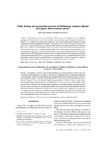Please use this identifier to cite or link to this item:
http://www.alice.cnptia.embrapa.br/alice/handle/doc/463606| Title: | Flight, feeding and reproductive behavior of Phyllophaga cuyabana (Moser) (Coleoptera: Melolonthidae) adults. |
| Authors: | OLIVEIRA, L. J.  GARCIA, M. A.   |
| Date Issued: | 2003 |
| Citation: | Pesquisa Agropecuária Brasileira, Brasília, v. 38, n. 2, p. 179-186 , fev. 2003. |
| Description: | Phyllophaga cuyabana is a univoltine species and its development occurs completely underground. Its control by conventional methods, such as chemical and biological insecticides, is difficult, so it is important to understand its dispersion, reproduction, and population behavior in order to determine best pest management strategies. The objective of this work was to study the behavior of adults of P. cuyabana. This study was carried out in the laboratory, greenhouse and field sites in Paraná State, Brazil (24o25' S and 52o48' W), during four seasons. The results obtained demonstrate that: a) P. cuyabana adults have a synchronized short-flight period when mating and reproduction occurs; b) adults tend to aggregate in specific sites for mating; c) the majority of adults left the soil on alternate nights; d) the choice of mating and oviposition sites was made by females before copulation, since after copulation adults did not fly from or bury themselves at nearby locations; e) females that fed on leaves after mating, oviposited more eggs than females that had not fed; f) plant species such as sunflower (Helianthus annuus) and the Crotalaria juncea are important food sources for adults. |
| Type of Material: | Artigo de periódico |
| Access: | openAccess |
| Appears in Collections: | Artigo em periódico indexado (CNPSO)  |










